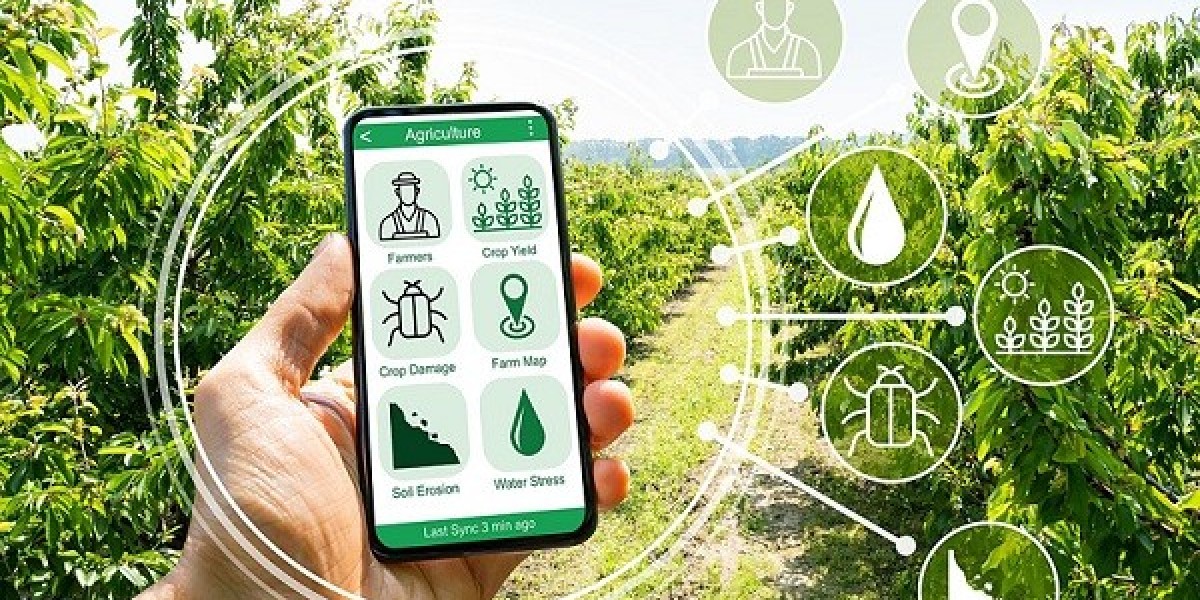Market Analysis
The Connected Agriculture Market is experiencing rapid growth driven by the increasing adoption of Internet of Things (IoT) technologies, advancements in data analytics, and a global shift towards sustainable farming practices. Connected agriculture leverages IoT devices, sensors, and cloud computing to optimize farming operations, enhance crop yields, reduce resource wastage, and improve overall farm management efficiency. The market is primarily propelled by the rising need for precision farming, which allows farmers to make data-driven decisions regarding irrigation, fertilization, pest control, and harvesting schedules.
Furthermore, the integration of artificial intelligence (AI) and machine learning (ML) into connected agriculture solutions enhances predictive analytics, enabling farmers to anticipate weather changes, pest outbreaks, and disease spread with higher accuracy. The COVID-19 pandemic underscored the importance of resilient and technology-driven farming systems, further accelerating investment and adoption in this sector. The global connected agriculture market is forecasted to continue its upward trajectory, driven by technological innovations, government initiatives supporting digital farming, and increasing awareness among farmers about the benefits of smart farming practices.
Market Key Players
The connected agriculture market comprises several key players contributing to technological innovations and market expansion. Leading companies include John Deere, a pioneer in integrating smart farming equipment and precision agriculture solutions; Trimble Inc., known for its advanced GPS and GIS-based farm management systems; AGCO Corporation, offering a range of connected machinery and digital solutions; Raven Industries, specializing in sensors, control systems, and precision application technologies; and Climate Corporation, a subsidiary of Bayer, delivering data-driven insights through its digital farming platform. Other notable players include CropX, providing soil sensing solutions; Semios, focusing on pest management through connected sensors; and IBM, offering AI-powered analytics platforms tailored for agriculture. These companies are investing heavily in R&D to develop innovative sensors, hardware, and software solutions that enable real-time monitoring and decision-making. Strategic collaborations, acquisitions, and partnerships are also prevalent as firms aim to expand their technological capabilities and global footprint in the connected agriculture landscape.
Get An Exclusive Sample of the Research Report at -
https://www.marketresearchfuture.com/sample_request/5218
Market Segmentation
The connected agriculture market can be segmented based on component, application, technology, and region. By component, the market is categorized into hardware (sensors, drones, GPS devices), software (farm management platforms, analytics tools), and services (consulting, system integration, maintenance). Application-wise, the market is divided into crop management, livestock monitoring, irrigation management, soil monitoring, and weather tracking. Technologies underpinning connected agriculture include IoT devices, cloud computing, AI & ML, Big Data analytics, and wireless communication protocols such as 4G/5G, NB-IoT, and LoRaWAN.
Regionally, the market is segmented into North America, Europe, Asia-Pacific, Latin America, and the Middle East & Africa, each exhibiting distinct adoption rates driven by technological infrastructure, government policies, and agricultural practices. North America and Europe currently lead the market due to early adoption, advanced infrastructure, and supportive regulatory frameworks, while Asia-Pacific is anticipated to witness the fastest growth owing to increasing agricultural modernization efforts in countries like India and China.
Market Dynamics
The dynamics driving the connected agriculture market are multifaceted. On the demand side, increasing pressure to meet global food security challenges, coupled with the need for resource-efficient farming, propels adoption. Farmers are seeking cost-effective and sustainable solutions to improve productivity amidst climate change and shrinking arable land. On the supply side, technological advancements such as miniaturization of sensors, affordable connectivity, and improved battery life make connected devices more accessible to farmers worldwide. Government initiatives and subsidies promoting digital farming practices further catalyze market growth.
However, challenges such as high initial investment costs, lack of technological literacy among smallholder farmers, data privacy concerns, and infrastructural barriers in rural areas hinder widespread adoption. The market is also influenced by geopolitical factors, trade policies, and environmental regulations that shape the pace and nature of technological integration. As stakeholders navigate these complexities, partnerships between technology providers, agricultural cooperatives, and government agencies are vital in fostering scalable and inclusive connected agricultural solutions.
Recent Development
Recent developments in the connected agriculture market highlight significant technological breakthroughs and strategic collaborations. Major players have introduced next-generation sensors with enhanced accuracy, durability, and low power consumption, facilitating more reliable and extensive data collection. The integration of 5G connectivity is enabling real-time data transmission, crucial for timely decision-making in precision farming. Furthermore, several companies are launching comprehensive farm management platforms that combine weather data, soil health metrics, and crop health monitoring into user-friendly dashboards. Notably, collaborations between agritech startups and established machinery manufacturers are resulting in integrated solutions that combine hardware and software for seamless operation. Governments and industry bodies are also launching pilot projects and funding programs to promote smart farming adoption.
For example, initiatives like the USDA's Precision Agriculture Grant Program and the European Union’s Digital Innovation Hubs are fostering innovation and dissemination of connected agriculture technologies. Additionally, the deployment of AI-powered predictive analytics and autonomous machinery is gaining traction, paving the way for more autonomous farm operations. These recent developments collectively underscore the sector’s rapid evolution and underscore the pivotal role of technology in shaping sustainable, efficient, and resilient agricultural systems.
Regional Analysis
Regionally, North America remains at the forefront of the connected agriculture market, driven by advanced technological infrastructure, substantial R&D investments, and supportive government policies promoting smart farming. The United States and Canada are deploying precision agriculture tools extensively across commercial farms, with widespread adoption of IoT sensors, drones, and data analytics platforms. Europe follows closely, with countries like Germany, the Netherlands, and the UK leading in farm digitization efforts, supported by EU funding and policies advocating sustainable agriculture. The Asia-Pacific region presents significant growth opportunities, particularly in China and India, where governments are actively promoting digital agriculture to address food security and rural development challenges.
Rapid urbanization, improving connectivity, and increasing farm mechanization are contributing to this surge. Latin America, especially Brazil and Argentina, is gradually adopting connected solutions driven by export-oriented agribusinesses seeking efficiency and competitiveness. The Middle East & Africa, while currently lagging due to infrastructural constraints, show promising potential as investments in digital infrastructure increase and governments initiate programs to modernize agriculture. Overall, regional disparities in technological adoption are influenced by factors such as economic development, government initiatives, infrastructure availability, and farmer awareness, shaping the global trajectory of the connected agriculture market.
Browse In-depth Market Research Report:
https://www.marketresearchfuture.com/reports/connected-agriculture-market-5218
Contact Us:
Market Research Future (Part of Wantstats Research and Media Private Limited)
99 Hudson Street, 5Th Floor
New York, NY 10013
United States of America
+1 628 258 0071 (US)
+44 2035 002 764 (UK)
Email: sales@marketresearchfuture.com






